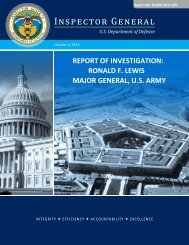Command Red Team
2gWzzvB
2gWzzvB
You also want an ePaper? Increase the reach of your titles
YUMPU automatically turns print PDFs into web optimized ePapers that Google loves.
<strong>Command</strong> <strong>Red</strong> <strong>Team</strong> Organization<br />
(3) Staff Support. <strong>Red</strong> teams should know how to integrate red team processes<br />
with regular planning, operations, intelligence support, assessment, and other staff<br />
functions, including the joint operation planning process (JOPP) and joint intelligence<br />
preparation of the operational environment (JIPOE) processes.<br />
(4) Alternative Analysis. <strong>Red</strong> team members should be familiar with<br />
techniques to stimulate the production and exploitation of new, original, independent, and<br />
unconventional perspectives, concepts, assessments, and COAs. In addition, members of<br />
the command red team should be familiar with existing assessments and prevailing<br />
wisdom, and the rationale behind them, so that they can develop alternative perspectives.<br />
(5) Situational Dynamics. <strong>Red</strong> teams should know how to explore potential<br />
second and third order effects, unintended and collateral effects, high impact/low<br />
probability events, unseen threats and opportunities, chaos, and the interplay of multivariable<br />
dynamics. In addition, members of the command red team should understand<br />
the specific factors and dynamics that apply to their particular area of responsibility<br />
(AOR) and problem sets.<br />
(6) Sociocultural Analysis. <strong>Red</strong> teams should have a solid understanding of<br />
the adversary and other relevant actor mindsets, cultural traits, world views, historical<br />
narratives and grievances, and operational perspectives applicable to their assigned AOR<br />
and area of interest, as well as area-specific sociocultural, human factors, and<br />
anthropological expertise. <strong>Red</strong> teams should be able to interpret information and assess<br />
situations from the perspective of adversaries, partners, and other relevant actors.<br />
<strong>Command</strong> red teams should be proficient in methods to forecast the probable behavioral<br />
responses of specific actors based on their known or inferred perspectives, mindsets,<br />
interests, doctrines, and decision-making processes.<br />
(7) Adversary Emulation. <strong>Red</strong> teams should be able to interpret information<br />
and assess situations from the perspective of adversaries, partners, and other relevant<br />
actors. <strong>Red</strong> teams should be proficient in methods to forecast the probable behavioral<br />
responses of specific actors based on their known or inferred perspectives, mindsets,<br />
interests, doctrines, and decision-making processes. Adversary emulation is not roleplaying<br />
all aspects of the enemy (a role reserved for the red cell) such as capabilities,<br />
force structure, doctrine, and rules of engagement.<br />
II-9



